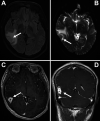Intracranial tuberculoma: a rare complication of extrapulmonary tuberculosis. Illustrative case
- PMID: 35855351
- PMCID: PMC9257396
- DOI: 10.3171/CASE2291
Intracranial tuberculoma: a rare complication of extrapulmonary tuberculosis. Illustrative case
Abstract
Background: Intracranial tuberculomas are rare entities commonly seen only in low- to middle-income countries where tuberculosis remains endemic. Furthermore, following adequate treatment, the development of intracranial spread is uncommon in the absence of immunosuppression.
Observations: A 22-year-old man with no history of immunosuppression presented with new-onset seizures in the setting of miliary tuberculosis status post 9 months of antitubercular therapy. Following a 2-month period of remission, he presented with new-onset tonic-clonic seizures. Magnetic resonance imaging demonstrated interval development of a mass concerning for an intracranial tuberculoma. After resection, pathological analysis of the mass revealed caseating granulomas within the multinodular lesion, consistent with intracranial tuberculoma. The patient was discharged after the reinitiation of antitubercular medications along with a steroid taper.
Lessons: To the best of the authors' knowledge, this case represents the first instance of intracranial tuberculoma occurring after the initial resolution of a systemic tuberculosis infection. The importance of retaining a high level of suspicion when evaluating these patients for seizure etiology is crucial because symptoms are rapidly responsive to resection of intracranial tuberculoma masses. Furthermore, it is imperative for surgeons to recognize the isolation steps necessary when managing these patients within the operating theater and inpatient settings.
Keywords: CNS = central nervous system; CSF = cerebrospinal fluid; CT = computed tomography; DWI = diffusion-weighted imaging; MRI = magnetic resonance imaging; extrapulmonary tuberculosis; intracranial; tuberculoma.
© 2022 The authors.
Conflict of interest statement
Disclosures The authors report no conflict of interest concerning the materials or methods used in this study or the findings specified in this paper.
Figures



Similar articles
-
Pediatric intracranial tuberculoma: illustrative case.J Neurosurg Case Lessons. 2023 Jul 24;6(4):CASE23236. doi: 10.3171/CASE23236. Print 2023 Jul 24. J Neurosurg Case Lessons. 2023. PMID: 37539871 Free PMC article.
-
Spinal epidural tuberculoma with osseous involvement: illustrative case.J Neurosurg Case Lessons. 2023 Mar 13;5(11):CASE22376. doi: 10.3171/CASE22376. Print 2023 Mar 13. J Neurosurg Case Lessons. 2023. PMID: 36916527 Free PMC article.
-
Isolated cerebellar tuberculoma mimicking a malignant posterior cranial fossa tumor in a healthy child: A rare case report from Tanzania.Int J Surg Case Rep. 2023 Sep;110:108709. doi: 10.1016/j.ijscr.2023.108709. Epub 2023 Aug 23. Int J Surg Case Rep. 2023. PMID: 37633195 Free PMC article.
-
Diagnosis and management of intracranial tuberculomas: about 2 cases and a review of the literature.Pan Afr Med J. 2019 Sep 11;34:23. doi: 10.11604/pamj.2019.34.23.17587. eCollection 2019. Pan Afr Med J. 2019. PMID: 31762892 Free PMC article. Review.
-
Diagnostic and Neurological Overview of Brain Tuberculomas: A Review of Literature.Cureus. 2021 Dec 3;13(12):e20133. doi: 10.7759/cureus.20133. eCollection 2021 Dec. Cureus. 2021. PMID: 34900500 Free PMC article. Review.
Cited by
-
Unusual presentation of miliary tuberculosis in a 12-year-old girl: a case report.BMC Pediatr. 2024 Apr 1;24(1):223. doi: 10.1186/s12887-023-04427-x. BMC Pediatr. 2024. PMID: 38561744 Free PMC article.
References
-
- Garg RK, Sharma R, Kar AM, et al. Neurological complications of miliary tuberculosis. Clin Neurol Neurosurg. 2010;112(3):188–192. - PubMed
-
- Bagga A, Kalra V, Ghai OP. Intracranial tuberculoma. Evaluation and treatment. Clin Pediatr (Phila) 1988;27(10):487–490. - PubMed
-
- Kioumehr F, Dadsetan MR, Rooholamini SA, Au A. Central nervous system tuberculosis: MRI. Neuroradiology. 1994;36(2):93–96. - PubMed
-
- Rajshekhar V. Surgery for brain tuberculosis: a review. Acta Neurochir (Wien) 2015;157(10):1665–1678. - PubMed
Publication types
LinkOut - more resources
Full Text Sources

